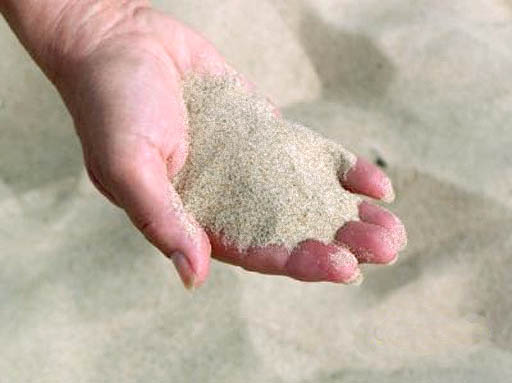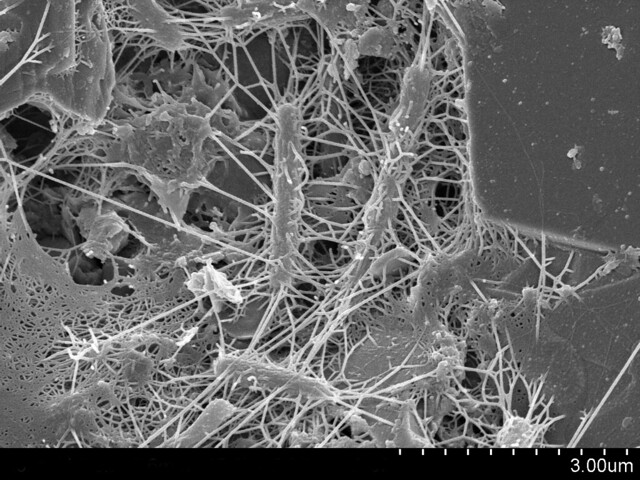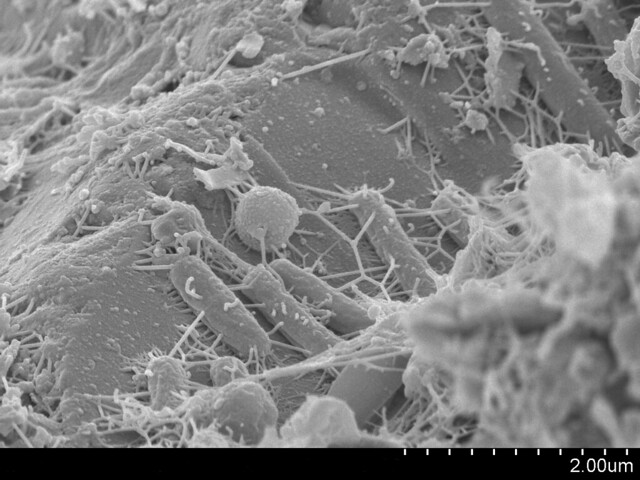I day dream about subterranean life, thanks to a book I just finished (“Tales of the Underground”, by David Wolf) This is not a horror or suspense story, but a natural history of life in the soil. I bought the book because I am intrigued by the number of “larger” animals who live underground. In this book, however, I learned about microscopic life. Thanks to DNA studies, we know that the first bit of life came from the soil, not the oceans. This discovery led to a new Tree of Life theory: no more Plant and Animal Kingdoms, but a system of domains that start with microbes.
 As I walked on the beach this morning, I started wondering about sand. What does it harbor besides clams and crabs? Does a similar network of microbial life thrive in sand? I think of sand as sharp, inhospitable, inert. Discover Magazine, in an article titled, “Life on a Grain of Sand”, tells me that life in the sand is as diverse as in the Amazon Rain Forest. Meiofauna (MY-oh-FAWN-uh) are microscopic, but bigger than bacteria and number about 10,000 in a cup or so of wet sand. It is a rich and complex microworld and each year, scientists discover a dozen more species of meiofauna living in sand. So far, the count includes crawling, swirling, pinching and oozing critters, such as worms and shrimp-like meiofauna. One newly discovered meiofauna has a feathery plume, like a ladies hat. Each has learned to hang on to a grain of sand because they cannot swim and the incoming tides would otherwise wash them out to sea.
As I walked on the beach this morning, I started wondering about sand. What does it harbor besides clams and crabs? Does a similar network of microbial life thrive in sand? I think of sand as sharp, inhospitable, inert. Discover Magazine, in an article titled, “Life on a Grain of Sand”, tells me that life in the sand is as diverse as in the Amazon Rain Forest. Meiofauna (MY-oh-FAWN-uh) are microscopic, but bigger than bacteria and number about 10,000 in a cup or so of wet sand. It is a rich and complex microworld and each year, scientists discover a dozen more species of meiofauna living in sand. So far, the count includes crawling, swirling, pinching and oozing critters, such as worms and shrimp-like meiofauna. One newly discovered meiofauna has a feathery plume, like a ladies hat. Each has learned to hang on to a grain of sand because they cannot swim and the incoming tides would otherwise wash them out to sea.
So, what is the role of these billions of tiny creatures clinging to the sand? The Discover article points out that they are janitors of the beach, like Turkey Vultures in the forests! They digest debris and naturally-occuring pollutants. When they live in man-polluted beaches, they die off and, therefore, their presence is also a good indicator of beach health.
Meiofauna in wet sand:

 We cannot see this micro life, but I did see some burrow holes in the sand this morning. They were about the size of a quarter. I was well above the high tide line so I knew it wasn’t clams or crabs. Perhaps, it was home to a beetle, carnivorous worm, or ??? Sand dunes are another story altogether, with plants, trees, birds and diverse wetlands. However, nothing tweaks my imagination more than thinking about the teeny tiny living organisms doing all that hard work cleaning the beaches while I sit around.
We cannot see this micro life, but I did see some burrow holes in the sand this morning. They were about the size of a quarter. I was well above the high tide line so I knew it wasn’t clams or crabs. Perhaps, it was home to a beetle, carnivorous worm, or ??? Sand dunes are another story altogether, with plants, trees, birds and diverse wetlands. However, nothing tweaks my imagination more than thinking about the teeny tiny living organisms doing all that hard work cleaning the beaches while I sit around.



